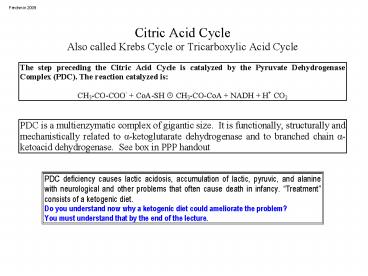TCA 092009 - PowerPoint PPT Presentation
1 / 18
Title: TCA 092009
1
Ferchmin 2009
2
Steps shown and enzymes involved. 1 and 2)
Pyruvate dehydrogenase (not decarboxylase). 3 and
4) Dihydrolipoyl transacetylase. 5)
Dihydrolipoyl dehydrogenase
How come NADH transfers H to FAD?
Fully reduced lipoic
3
Remainder. Did you look into these issues when we
studied the pentose phosphate shunt?
4
The pyruvate dehydrogenase complex is s true
multienzymatic complex
Model of the PDC of E. coli. Red E1 pyruvate
dehydrogenase Yellow E2 transacetylase Green
E3 dihydrolipoyl dehydrogenase
Electron micrography of the PDC of E. coli.
5
(No Transcript)
6
Regulation of the PDC by allosteric and covalent
modulation
In green, activators of the PDC, in reddish,
inhibitors of PDC. Conceptualize that an
inhibitor of an inhibitory enzyme is in a way an
activator. Or in mathematical terms (-1)x(-2)-2
Insulin (means abundance of glucose) disinhibits
the PDC and reroutes pyruvate from
gluconeogenesis to lipogenesis
Ca2 in muscle insulin in liver
7
Malate leaves the mitosol and goes into
gluconeogenesis
Stoichiometry of the Krebs Cycle CH3-CO-CoA 3
NAD FAD GDP Pi 2 H2O ? 2 CO2 3 NADH
FADH2 GTP 2 H CoA ?G1.1 kcal/mole
(sluggish)
AcCoA never leaves mito to favor TCA
but citrate leaves the mito. and serves as
substrate for lipid synthesis
Availability of oxaloacetate (OAA) is one of the
main limiting steps of TCA. The OAA is 1/10 of
the other intermediates of TCA. Remember pyruvate
carboxylase is anaplerotic. Why Acetyl-CoA
activates pyruvate carboxylase? Do you remember
from glycolysis that the active metabolite
(glyceraldehyde) is often kept in short supply?
Succinate dehydrogenase is part of the mito.
membrane and the respiratory chain
Isocitrate dehydrogenase is the key enzyme
(committed step). Strictly dependent on the
ration of ADP/ATP and NAD/NADH. Makes TCA
aerobic by the substrate control. Raitza
entendiste que es estar compropmetida?
SuccinylCoA accumulates in mitosol and serves as
feedback inhibitor of citrate synthase, donor of
CoA to activate ketone bodies and fatty acids
and is also a precursor of porphyrines.
Odd carbon number fatty acids enter here and
contribute to gluconeogenesis exiting the TCA as
malate.
Very similar to PDC but has no intrinsic protein
kinases phosphatases. Otherwise has the same
regulation
8
Aconitase is inhibited by fluoroacetate an enzyme
activated inhibitor (often called suicidal enzyme
inhibitor).
Malonic acid is the archetypal example of a
competitive inhibitor it acts against succinate
dehydrogenase (complex II) in the respiratory
electron transport chain.
Odd carbon acids converts into propionyl-CoA
which cannot directly enter either beta oxidation
or the citric acid cycles. Instead it is
carboxylated to D-methylmalonyl-CoA, which is
isomerized to L-methylmalonyl-CoA. A vitamin
B12-dependent enzyme catalyzes rearrangement of
L-methylmalonyl-CoA to succinyl-CoA, which is an
intermediate of the citric acid cycle.
9
(No Transcript)
10
This slide is just to reinforce the activators
and inhibitors
11
The cycle is totally aerobic because of substrate
(availability) control. Notice however, that O2
is not actually present.
The indicate the requirement of an oxidized
NAD or FAD for the TCA to proceed. The II
indicate the requirement of ADP for the cycle to
proceed.
12
The puzzle
During the first turn of the cycle no carbon from
the Acetyl-CoA is released as CO2. Since
citrate is symmetric this is impossible. Is
citrate symmetric? What is going on?
13
(No Transcript)
14
(No Transcript)
15
(No Transcript)
16
(No Transcript)
17
(No Transcript)
18
(No Transcript)































